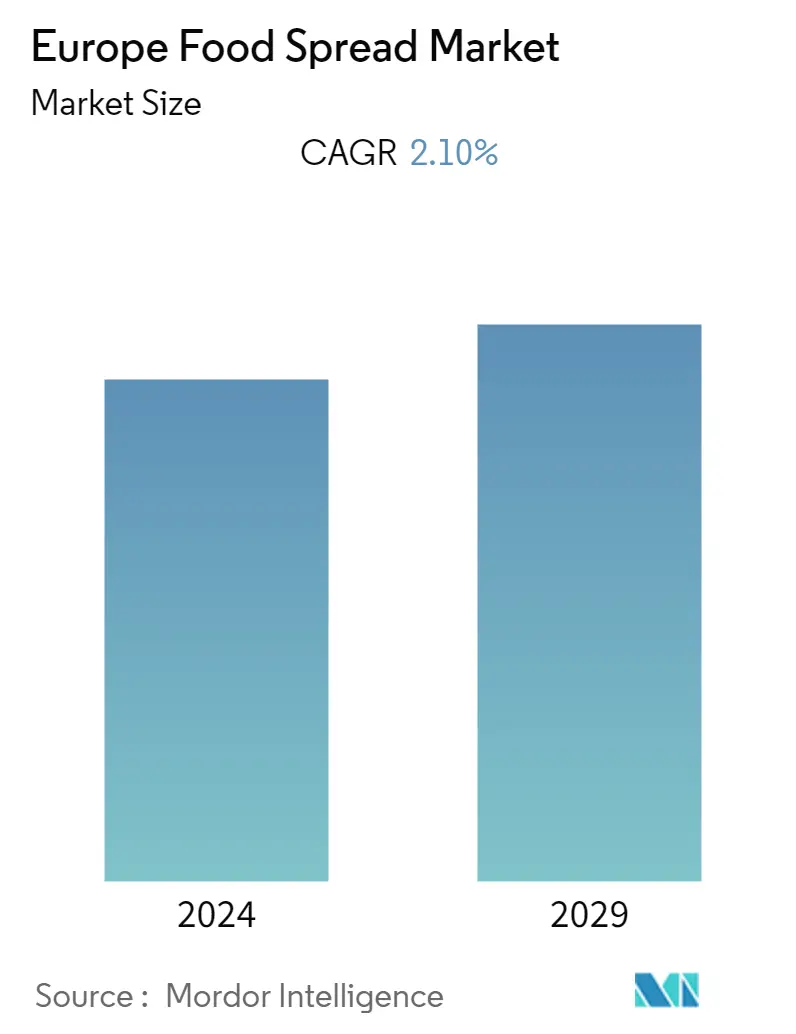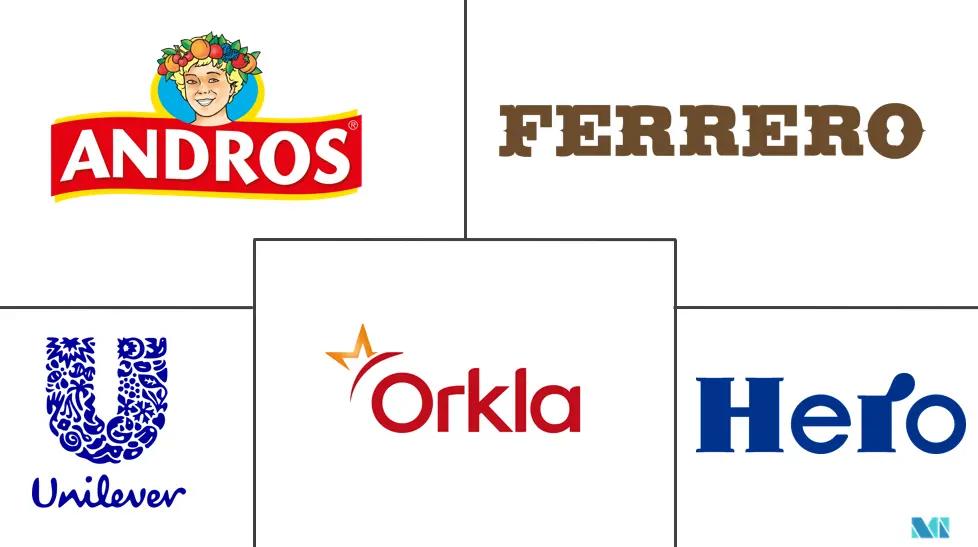Market Size of Europe Food Spread Industry

| Study Period | 2019 - 2029 |
| Base Year For Estimation | 2023 |
| Forecast Data Period | 2024 - 2029 |
| Historical Data Period | 2019 - 2022 |
| CAGR | 2.10 % |
| Market Concentration | Low |
Major Players
*Disclaimer: Major Players sorted in no particular order |
Europe Food Spreads Market Analysis
Europe's food spread market is projected to register a CAGR of 2.1% over the forecast period.
- The trend of health consciousness among consumers has led to an increased demand for nutritious and healthy spreads free from additives, preservatives, gluten, and trans-fat. Consumers increasingly prefer natural or low-sugar and sugar-free spreads, which may lead to long-term changes in customer behavior and demand.
- The European food spread market is closely tied to ethnic flavors, raw material perceptions, and the consumption patterns of bread. The demand for 100% fruit-based spreads is a significant factor driving the market. In the United Kingdom, changing consumer preferences and cautious spending habits are influencing the types of sweet spreads purchased.
- Currently, the jams and jellies segment holds the largest share of the market. It is expected to remain a significant segment during the forecast period due to its high market penetration and product reinvigoration by manufacturers. The COVID-19 pandemic led European consumers to adopt healthier lifestyles, resulting in increased consumption of hazelnut-based spreads, which are associated with a lower risk of heart disease. As a result, the nut-based spread market is expected to register further growth due to changing consumer preferences.
Europe Food Spreads Industry Segmentation
- A spread is a food that is applied, generally with a knife, onto foods such as bread and crackers. Spreads are added to food to enhance the flavor or texture of the food, which may be considered bland without it.
- The European food spread market is segmented by product type, distribution channel, and geography. Based on the product type, the market is segmented into nut and seed-based spreads, fruit-based spreads, honey, chocolate-based spreads, and other product types. Based on the distribution channel, the market is segmented into supermarkets/hypermarkets, convenience stores, specialist retailers, online retail stores, and other distribution channels. Based on geography, the market is segmented into Spain, the United Kingdom, Germany, France, Italy, Russia, and the Rest of Europe.
- For each segment, the market sizing and forecasts have been done on the basis of value (in USD million).
| Product Type | |
| Nut and Seed-based Spread | |
| Fruit-based Spread | |
| Honey | |
| Chocolate-based Spread | |
| Other Product Types |
| Distribution Channel | |
| Supermarkets/Hypermarkets | |
| Convenience Stores | |
| Specialist Retailers | |
| Online Retail Stores | |
| Other Distribution Channels |
| Geography | |
| Spain | |
| United Kingdom | |
| Germany | |
| France | |
| Italy | |
| Russia | |
| Rest of Europe |
Europe Food Spread Market Size Summary
The European food spread market is experiencing a steady growth trajectory, driven by evolving consumer preferences towards healthier and more natural options. There is a notable shift towards spreads that are free from additives, preservatives, gluten, and trans-fats, with a growing demand for low-sugar and sugar-free alternatives. This trend is particularly evident in the increasing popularity of nut-based spreads, which are perceived as healthier choices. The market is also influenced by the rising interest in ethnic flavors and the consumption patterns associated with bread. The jams and jellies segment currently dominates the market, benefiting from high penetration and ongoing product innovation. The COVID-19 pandemic has further accelerated the shift towards healthier lifestyles, contributing to the growth of hazelnut-based spreads.
The market landscape is characterized by a diverse range of products and intense competition among national and international brands. Key players such as Hero Group, Unilever PLC, Andros, Ferrero International S.A., and Orkla ASA are actively innovating and expanding their product offerings to meet consumer demands. The rise of organized retailing and private-label brands has also played a significant role in market expansion. Additionally, strategic partnerships and enhancements in distribution channels have enabled these companies to maintain a competitive edge. The introduction of premium quality products with eco-friendly packaging and unique flavor profiles, such as those incorporating adaptogenic herbs, reflects the industry's commitment to catering to health-conscious consumers.
Europe Food Spread Market Size - Table of Contents
-
1. MARKET DYNAMICS
-
1.1 Market Drivers
-
1.2 Market Restraints
-
1.3 Porter's Five Forces Analysis
-
1.3.1 Threat of New Entrants
-
1.3.2 Bargaining Power of Buyers/Consumers
-
1.3.3 Bargaining Power of Suppliers
-
1.3.4 Threat of Substitute Products
-
1.3.5 Intensity of Competitive Rivalry
-
-
-
2. MARKET SEGMENTATION
-
2.1 Product Type
-
2.1.1 Nut and Seed-based Spread
-
2.1.2 Fruit-based Spread
-
2.1.3 Honey
-
2.1.4 Chocolate-based Spread
-
2.1.5 Other Product Types
-
-
2.2 Distribution Channel
-
2.2.1 Supermarkets/Hypermarkets
-
2.2.2 Convenience Stores
-
2.2.3 Specialist Retailers
-
2.2.4 Online Retail Stores
-
2.2.5 Other Distribution Channels
-
-
2.3 Geography
-
2.3.1 Spain
-
2.3.2 United Kingdom
-
2.3.3 Germany
-
2.3.4 France
-
2.3.5 Italy
-
2.3.6 Russia
-
2.3.7 Rest of Europe
-
-
Europe Food Spread Market Size FAQs
What is the current Europe Food Spread Market size?
The Europe Food Spread Market is projected to register a CAGR of 2.10% during the forecast period (2024-2029)
Who are the key players in Europe Food Spread Market?
Hero Group, Unilever PLC, Andros , Ferrero International S.A. and Orkla ASA are the major companies operating in the Europe Food Spread Market.

